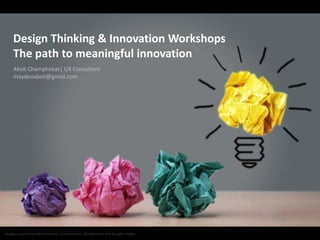
INDIAHCI2016_DesignThinking&Innovation_Workshops_Aboli
- 1. Design Thinking & Innovation Workshops The path to meaningful innovation Images courtesy Anders Ramsay’s presentation, Shutterstock and Google images Aboli Champhekar| UX Consultant maydeoaboli@gmail.com
- 2. Design Thinking “Design thinking is a human-centered approach to innovation that draws from the designer's toolkit to integrate the needs of people, the possibilities of technology, and the requirements for business success.” —Tim Brown, CEO IDEO
- 3. Design Thinking Process | Ideate & Prototype Image by D School. Institute of Design at Stanford Learn about the audience for whom you are designing Construct a point of view based on user needs and insights Brainstorm and come up with creative solutions Return to your original user group and test your ideas for feedback Build a representation of one or more of your ideas to show others Learn about the audience for whom you are designing Construct a point of view based on user needs and insights Brainstorm and come up with creative solutions Return to your original user group and test your ideas for feedback Build a representation of one or more of your ideas to show others
- 4. Meaningful Innovation “Innovation that is truly useful for end users and impactful for business” Not merely resulting from emerging technology but comes from deeply knowing your users and caring about their lives.
- 5. Based on the 5 day design sprint by Google Ventures Highly flexible Useful in every stage of the project Workshops – What are they? And most of all…
- 6. Workshops are all about teamwork Everyone’s Participation is critical!
- 7. Workshop Steps Before, during and after a workshop
- 8. Have clearly defined goals Prioritize and distill business goals for the workshop. A ‘Problem Statement’ and ‘Outcome Statement’ is often useful when starting out. Step 1: Pre-requisites Know thy users Team should have a good understanding of the end users. This can be done through user research or market research (to some extent).
- 9. Let the UX practitioner lead the way… UX practitioners (researchers or designers) have a good understanding of the design process, UX methods and ideation techniques. They should lead and facilitate everything before, during and after the workshop Step 2: Planning Get all key stakeholders together Multi-disciplinary team to bring different perspectives on the table e.g. business, marketing, technology, management, design and so on. Ideal team size is 5-8 people
- 10. Step 3: Kickoff Dive in! Share the agenda Keep participants interested about what’s coming. If it is a multiple day workshop provide an overview then detail out current day Research and problem statement read out Recap what is learnt so far about the users, their pain points and problems. Pick up a problem statement and begin ideating.
- 11. Step 3: Kickoff Knowns and constraints At times there are constraints that need to be kept in mind when ideating. Post ‘Knows and Constraints’ and ‘Design Guidelines’ in large format in the room. Persona meet and greet Post large format personas in room and let participants read and reflect on them.
- 12. Step 4: Dive into ideation! What is divergent & convergent thinking?
- 13. Techniques & Activities Effective techniques, activities and games for breakthrough idea generation
- 14. User flow & Journey mapping Define
- 15. Post Ups Card Storming/ Post-ups/ Affinity mapping Diverge
- 16. Crazy 8’s or 4’s (followed by best idea) Diverge
- 18. Tips & Pitfalls Some useful tips, common pitfalls and observations
- 19. Tips Keep activities fast paced and time bound Use a timer for each activity. This keeps the team moving, get more done in less time and churn out multiple concepts without making a single concept too precious. Keep decision makers in the loop Involve management/ decision makers in the workshop. If they cannot be part of the workshop ensure they are in the loop and in sync with the design decisions. Key stakeholders also help focus on prioritization and correct things to build based on budget and goals. Tackle small but critical problems first! Do not make the workshop goals too ambitious. Scope out some less important problems from a workshop and handle them later.
- 20. After the Workshop keep these things in mind…
- 21. After the workshop Create a report Document problems tackled and all solutions uncovered. Park solutions into a ‘parking lot’ section for future reference or for product roadmap creation Digitalize all artefacts. Create low fidelity wireframes to validate early concepts, click-through prototypes to test specific flows and high fidelity wireframes to test user behavior Follow through Follow through the entire design and development process to ensure design decisions made during the workshop and testing are translated into the actual product
- 22. Avoid featuritis Think MVP After the workshop MVP lean cake image by Google images
- 23. Ideating outside the workshop setting Useful techniques when a full fledged workshop is not feasible
- 24. Design Thinking: Outside of a workshop setting Ideate in smaller sessions Get together a few associates in an informal setting and conduct specific targeted activities from the workshop Collaborate remotely Collaborate and ideate with remote members using online tools like Realtimeboard, Google Hangouts, Slack and so on Individual Design Thinking Use all the steps in the workshop on your own. Follow the process of design thinking when creating concepts.
- 26. Thank You! Images courtesy Anders Ramsay’s presentation, Shutterstock and Google images Aboli Champhekar| UX Consultant maydeoaboli@gmail.com